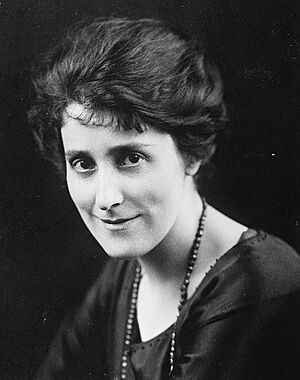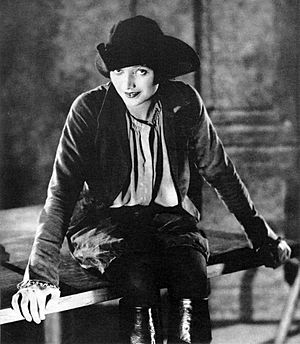Clemence Dane facts for kids
Quick facts for kids
Clemence Dane
|
|
|---|---|
 |
|
| Born | Winifred Ashton 21 February 1888 Blackheath, England |
| Died | 28 March 1965 (aged 77) London, England |
| Pen name | Clemence Dane |
| Occupation | Novelist, playwright |
| Notable works | Regiment of Women (1914) |
Winifred Ashton CBE, known by her pen name Clemence Dane (born February 21, 1888 – died March 28, 1965), was a famous English writer. She wrote many novels and plays.
Contents
Life as a Writer
After finishing her studies, Clemence Dane worked as a French tutor in Switzerland. She later returned home and studied art in London and Germany. After the First World War, she taught at a girls' school. This is when she started her writing career. She chose the name "Clemence Dane" from a church in London called St Clement Danes.
Early Books and Plays
Her first novel, Regiment of Women, was written in 1914. It explored life in a girls' school. In 1919, she wrote Legend. This book was about friends discussing the life of a friend who had passed away.
One of her most famous plays was A Bill of Divorcement (1921). It told the story of a daughter caring for her unwell father. This play was a huge success! It was even made into a movie three times. The first movie was silent, made in 1922. Then came a 1932 film starring Katharine Hepburn. Finally, a 1940 film featured Maureen O'Hara.
Writing for the Big Screen
Clemence Dane also started writing screenplays for movies. She traveled to Hollywood several times to work on films. In England, she worked with the famous filmmaker Alexander Korda.
She helped write the script for Anna Karenina, which starred Greta Garbo. She also worked on Fire over England. This movie starred young actors Laurence Olivier and Vivian Leigh.
Her biggest movie success was winning an Academy Award. She won it with Anthony Pelissier for the film Perfect Strangers (released as Vacation from Marriage in the U.S.). This movie was about a married couple changed by their experiences in the Second World War.
Supporting Women's Freedom
When Clemence Dane was 30, she was able to vote for the first time. This was thanks to a new law passed in 1918. In 1926, she shared her thoughts in an article called The Women's Side. She believed women should use their new freedoms to do more. She wrote for a magazine called Time and Tide. She was also part of a group called the Six Point Group, which worked for women's rights.
More Popular Works
In 1931, Dane's novel Broome Stages became a surprise bestseller. It followed the story of an acting family through many generations.
Clemence Dane also wrote detective novels with her friend Helen de Guerry Simpson. They created a detective character named Sir John Saumarez. Their first book, Enter Sir John, was made into a film by Alfred Hitchcock in 1930. The movie was called Murder!. Dane also contributed to mystery stories written by a group of writers called the Detection Club.
Her 1939 novel, The Arrogant History of White Ben, was a story about a difficult future world.
Later Years and Legacy
Clemence Dane's last play was Eighty in the Shade (1959). She wrote it for her good friend, Dame Sybil Thorndike, who starred in it.
Early in her career, Dane had tried acting herself. She even used a different stage name, Diana Cortis. Years later, her friend Noël Coward wrote a special part for her in his play Blithe Spirit. It was the role of Madame Arcati, an unusual medium.
The National Portrait Gallery in London has two artworks by Clemence Dane. Both are portraits of Noël Coward. The gallery also has a portrait of Clemence Dane herself.
In 1955, Dane helped edit a series of science fiction novels called Novels of Tomorrow. She also wrote a book about the history of Covent Garden in London, where she lived. It was called London has a Garden and came out in 1964.
Clemence Dane was awarded the CBE in 1953 for her contributions. By the time she passed away in London on March 28, 1965, she had written over 30 plays and 16 novels.
Novels and Plays
- Regiment of Women (1917)
- First the Blade: A Comedy of Growth (1918)
- Legend (1919)
- A Bill of Divorcement (1921)
- Will Shakespeare: An Invention in Four Acts (1921)
- Shivering Shocks or The Hiding Place (published in The Graphic Christmas Number, 1922) - a play for boys
- Naboth's Vineyard: A Piece in Three Acts (1925)
- Granite (1926)
- The Women's Side (1926)
- The Babyons (1927)
- The Dearly Beloved of Benjamin Cobb (1927) - short story
- Mariners (1927)
- Adam’s Opera: The Text of a Play (1928)
- Enter Sir John (1928) (with Helen Simpson)
- Third Person Singular (1928)
- The King Waits (1929)
- Printer's Devil, published in US as Author Unknown (1930) (with Helen Simpson)
- Broome Stages (1931)
- Theater Royale (1931)
- Re-enter Sir John (1932) (with Helen Simpson)
- Julia Newberry's Diary (1933)
- Come of Age: The Text of a Play in Music and Words (1934) (with Richard Addinsell)
- Moonlight is Silver: A Play in Three Acts (1934)
- Wild Decembers: A Play in Three Acts (1932)
- Edmond Rostand's L'aiglon (1934)
- The Amateur Gentleman: From the Novel By Jeffery Farnol (1936)
- The Moon Is Feminine. A novel (1938)
- Hebbel's Herod and Mariamne (1938)
- The Arrogant History of White Ben (1939)
- The Lion and the Unicorn. A Play in Three Acts (1943)
- He Brings Great News. A novel (1946)
- Bonny Prince Charlie (1948) (with Dorothy Middleton)
- The Flower Girls. A novel (1954)
- Eighty in the Shade (1959)
- Marriage Lines (1949)
- The Godson: A Fantasy (1964)
Non fiction
- Claude Houghton: Appreciations (with Hugh Walpole)
- London has a Garden (1964)
- The Welcoming Land (poem)


